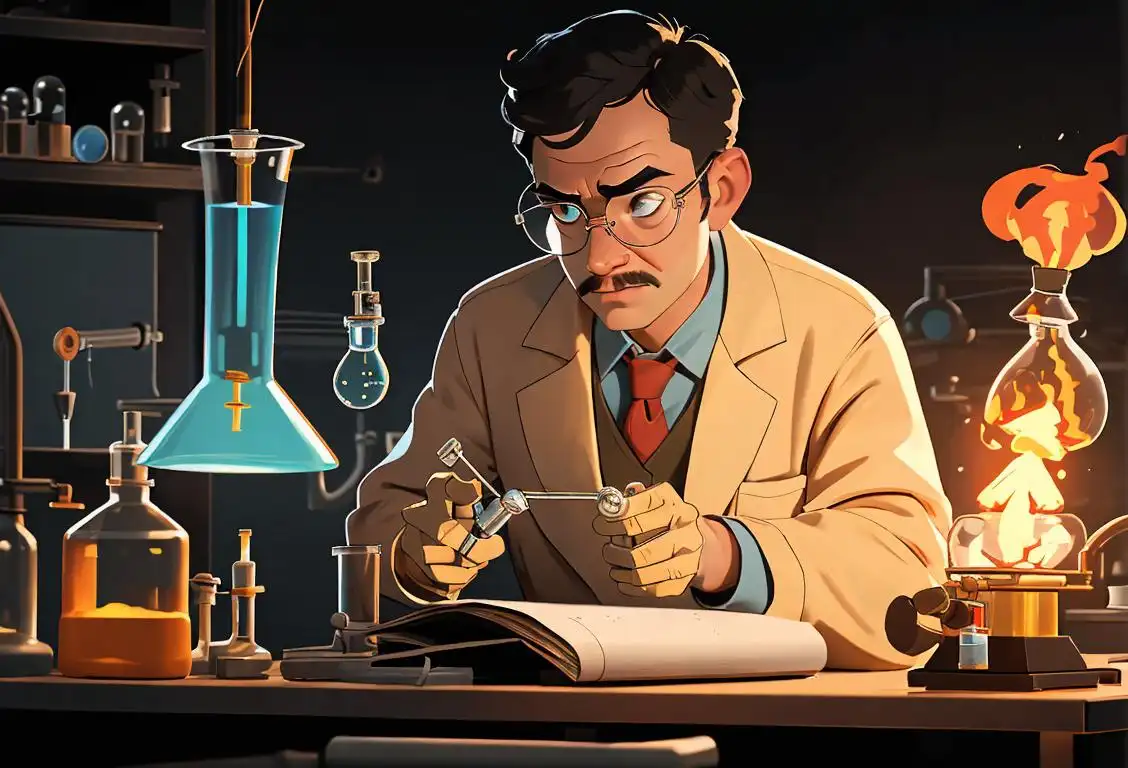National Bunsen Burner Day

Welcome to National Bunsen Burner Day, a day dedicated to the fiery marvel that has been burning its way into our hearts! Get ready to turn up the heat and discover the fascinating history and significance behind this iconic scientific instrument.
When is Bunsen Burner Day?
It's national bunsen burner day on the 31st March.
The Birth of the Bunsen Burner
The Bunsen Burner, named after its German inventor Robert Wilhelm Bunsen, is the ultimate tool for scientists and chemistry enthusiasts alike. Bunsen, a renowned chemist and inventor, developed this iconic device back in the 19th century as a safer and more controllable alternative to the open flame methods used at the time.
The Bunsen Burner consists of a metal tube attached to a base where gas, commonly methane or propane, is mixed with air and ignited to produce a steady flame. The adjustable air intake allows scientists to control the intensity and temperature of the flame, making it a versatile tool for various experiments and applications.
Celebrating National Bunsen Burner Day
On this special day, scientists, educators, and chemistry enthusiasts around the world come together to celebrate the marvels of chemistry and the indispensable role of the Bunsen Burner. Whether you're conducting experiments in a lab or simply marveling at the wonders of science, take a moment to appreciate the Bunsen Burner's contribution to our understanding of the world around us.
Here are a few fun ways you can celebrate National Bunsen Burner Day:
- Perform chemistry experiments using a Bunsen Burner (safely, of course!)
- Organize a science fair or chemistry demonstration
- Learn more about famous chemists and their groundbreaking discoveries
Did You Know?
Did you know that the middle part of the flame produced by a Bunsen Burner is called the 'inner cone'? This part of the flame is the hottest, reaching temperatures of up to 1500 degrees Celsius (2700 degrees Fahrenheit)! It's the perfect spot for conducting precise and controlled heating during experiments.
History behind the term 'Bunsen Burner'
1844
The Birth of a Chemist's Tool
In 1844, German chemist Robert Wilhelm Bunsen invented a revolutionary tool that would forever change the field of chemistry. This tool, known as the Bunsen burner, was designed to produce a hot, clean, and controllable flame for laboratory experiments. Bunsen's invention quickly gained popularity due to its efficiency and versatility, allowing scientists to perform a wide range of chemical reactions and heating processes.
1855
The Invention of the Bunsen Burner
In 1855, German chemist Robert Wilhelm Bunsen invented the precursor to the Bunsen burner. Bunsen was working at the University of Heidelberg when he created a new type of burner to improve the quality of flame in his laboratory experiments. His design featured a vertical tube with adjustable air intake, resulting in a more controlled and hotter flame compared to previous burners.
1855
The Gas Jets Ignite
As the use of natural gas spread across Europe in the mid-19th century, the Bunsen burner became even more widely adopted. The burner's design was modified to incorporate a gas inlet at the base, which allowed for a steady flow of controlled gas to be mixed with air and ignited. This new feature greatly improved the burner's performance, making it an essential tool in laboratories around the world.
1862
Perfection of the Bunsen Burner
In 1862, Bunsen collaborated with his laboratory assistant, Peter Desaga, to refine and perfect the design of the burner. Desaga made several modifications, including the addition of a chimney to regulate airflow and further enhance the controllability of the flame. The improved Bunsen burner quickly gained popularity among chemists and scientists around the world, becoming an essential tool in laboratories.
20th century
A Fixture in Laboratories
Throughout the 20th century, the Bunsen burner cemented its status as an indispensable tool in scientific laboratories. Its reliability, portability, and ease of use made it a staple for chemistry experiments, research, and education. The burner's characteristic blue flame provided a consistent heat source for various applications, such as heating solutions, sterilizing equipment, and conducting flame tests.
Late 19th Century
Spread and Adoption of the Bunsen Burner
Throughout the late 19th century, the Bunsen burner gradually gained widespread adoption in various scientific disciplines. Its versatility, ease of use, and precise flame control made it an indispensable tool for experiments, particularly in chemistry and biology. The burner proved instrumental in conducting heat-intensive reactions, sterilizing laboratory equipment, and performing flame-based analyses.
20th Century
Bunsen Burner in Education and Popular Culture
In the 20th century, the Bunsen burner became a staple in science classrooms worldwide. Its presence in educational settings exposed countless students to practical laboratory techniques and aided in their understanding of chemical processes. The iconic image of a blue flame atop a Bunsen burner has been deeply ingrained in popular culture, often serving as a symbol of scientific experimentation and discovery.
Modern Times
Beyond the Laboratory
In modern times, the Bunsen burner has transcended its original role in laboratories and found applications in other fields as well. It is commonly used for heating and welding in metalworking, jewelry making, and glassblowing. Additionally, the Bunsen burner has become an iconic symbol of science, frequently depicted in scientific illustrations, textbooks, and movies, further highlighting its cultural impact and recognition.
Present Day
Continued Use and Advancements
Even in the age of modern technology, the Bunsen burner remains an indispensable tool in many scientific laboratories. Its simple yet effective design continues to be used for a variety of purposes, from basic experiments to complex research applications. While advancements in laboratory equipment and techniques have emerged, the Bunsen burner remains a reliable and widely recognized symbol of scientific inquiry and discovery.
Did you know?
Did you know that the middle part of the flame produced by a Bunsen Burner is called the 'inner cone'? This part of the flame is the hottest, reaching temperatures of up to 1500 degrees Celsius (2700 degrees Fahrenheit)! It's the perfect spot for conducting precise and controlled heating during experiments.Tagged
fun education scienceFirst identified
31st March 2015Most mentioned on
31st March 2016Total mentions
335Other days
Youth Science Day
Bunsen Burner Day
Fossil Day
Virus Appreciation Day
Lab Day
Mole Day
Dna Day
Stem Day
Periodic Table Day
Metric Day








